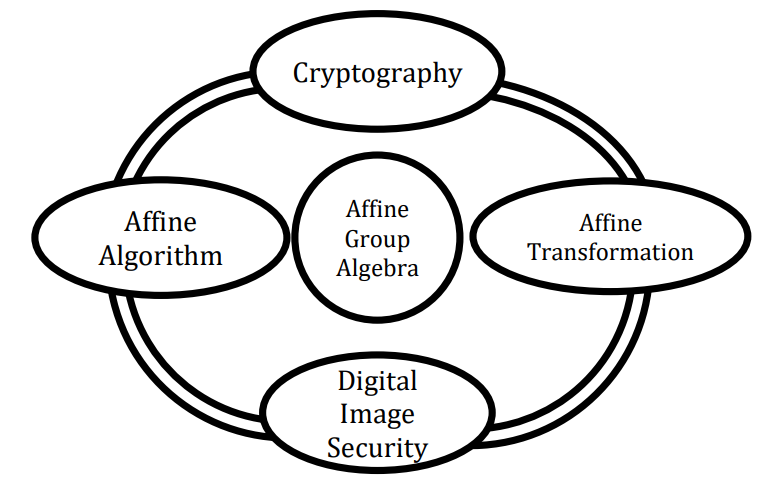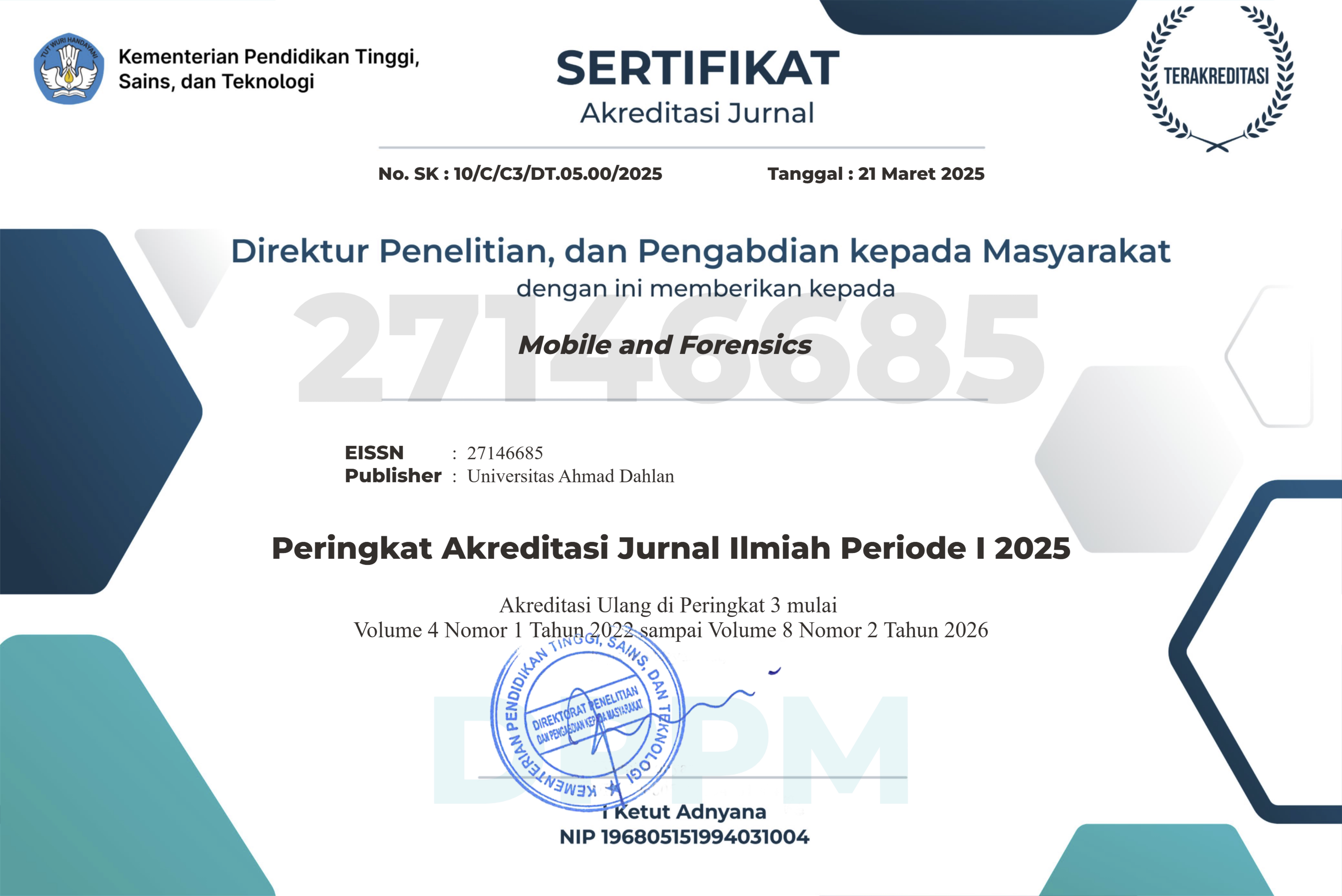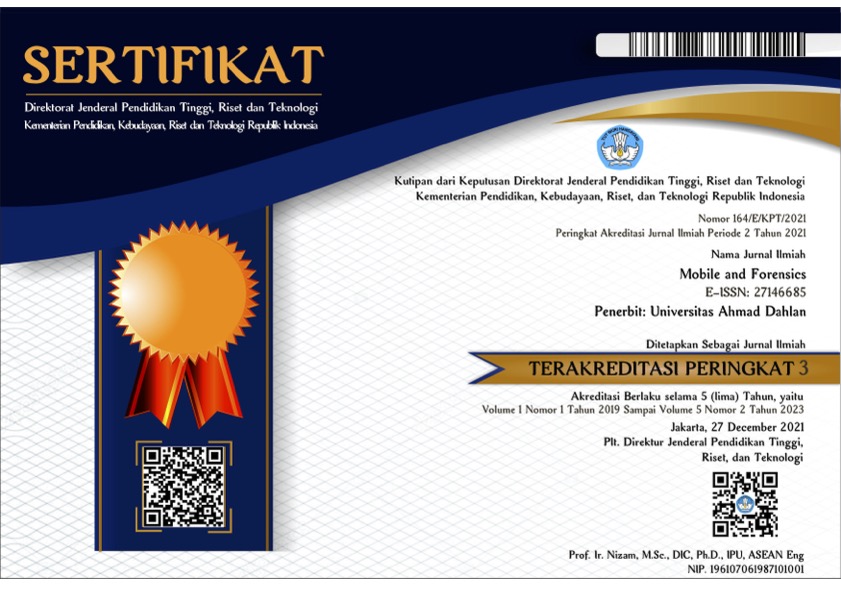The Implementation of Affine Group Algebra on Digital Image Security
DOI:
https://doi.org/10.12928/mf.v4i2.5992Keywords:
Crypthography, Affine Transform, Affine Group, Digital ImageAbstract
The concept of group theory has been applied to digital image security using the DES algorithm and wavelet transform. Affine Cipher algorithm was a symmetric cryptographic algorithm. This was
initiated for studying further the implementation of the Affine group on the Affine transformation.
More over, digital image used the Affine algorithm in security. The purpose of this paper was
described the implementation of the existence of an Affine Group in the Affine transformation carried out in digital image cryptography. The concept of maintaining geometric shapes in Affine
transformations and bijective nature of each Affine transformation could be formed an Affine group.
References
A. Yosanny, “Perancangan Enkripsi Pada Citra Bitmap Dengan Algoritma Des, Triple Des, dan Idea,” ComTech Comput. Math. Eng. Appl., vol. 1, no. 2, p. 853, 2010, doi: 10.21512/comtech.v1i2.2618.
S. El-Zoghdy, Y. Nada, and A. Abdo, “How Good Is The DES Algorithm In Image Ciphering?,” Int. J., vol. 803, no. February, pp. 796–803, 2011, [Online]. Available: http://ijana.in/papers/v2i5-1.pdf.
M. Toorani and A. Falahati, “A secure cryptosystem based on affine transformation,” Secur. Commun. Networks, vol. 4, no. 2, pp. 207–215, 2011, doi: 10.1002/sec.137.
E. S. Pasaribu, “Penerapan Aritmatika Modulusdan Matriks dalam Cipher Hill,” 2012.
M. L. Wijaya, K. Yulianti, and H. S. Husain, “Kriptografi Dengan Komposisi Caesar Cipher Dan Affine Cipher Untuk Mengubah Pesan Rahasia,” J. EurekaMatika, vol. 5, no. 1, pp. 30–45, 2017.
M. Ramalingam, N. A. Mat Isa, and R. Puviarasi, “A secured data hiding using affine transformation in video steganography,” Procedia Comput. Sci., vol. 171, no. 2019, pp. 1147–1156, 2020, doi: 10.1016/j.procs.2020.04.123.
A. Nag et al., “Image encryption using affine transform and XOR operation,” 2011 - Int. Conf. Signal Process. Commun. Comput. Netw. Technol. ICSCCN-2011, no. Icsccn, pp. 309–312, 2011, doi: 10.1109/ICSCCN.2011.6024565.
M. S. Rahmawati and R. Soekarta, “Teori Grup Pada Algoritma DES Dan Transformasi Wavelet Diskrit Dalam Program Aplikasi Keamanan Citra Digital,” Insect (Informatics …, vol. 4, no. 1, 2019, [Online]. Available: http://ejournal.um-sorong.ac.id/index.php/insect/article/view/281.
M. S. Rahmawati and R. Soekarta, “Penerapan Aljabar Linear pada Transformasi Wavelet Diskrit dalam Program Aplikasi Keamanan Citra Digital,” in SEMINAR MATEMATIKA DAN PENDIDIKAN MATEMATIKA UNY, 2019, pp. 1–6.
Q. Qin and N. Wang, “Wavelet transform associated to the affine group AGmp,” Approx. Theory its Appl., vol. 11, no. 4, pp. 45–50, 1995, doi: 10.1007/BF02836829.
S. A. Babu, P. Analyst, and R. Technologies, “Modification Affine Ciphers Algorithm for Cryptography Password,” Int. J. Res. Sci. Eng., vol. 3, no. 2, pp. 346–351, 2017.
B. Y. Chong and I. Salam, “Investigating deep learning approaches on the security analysis of cryptographic algorithms,” Cryptography, vol. 5, no. 4, 2021, doi: 10.3390/cryptography5040030.
Baha Eldin Hamouda Hassan, “Comparative study of different cryptographic algorithms,” J. Inf. Secur., vol. 11, pp. 138–148, 2020, doi: 10.4236/jis.2020.113009.
A. B. Nasution, “MODIFIKASI ALGORITMA AFFINE CIPHER UNTUK,” (Jurnal Teknol. Inf., vol. 4, no. 2, pp. 377–382, 2020.
M. Kharolina, “Implementasi Algoritma Affine Cipher Pada Citra Menggunakan Binomial Newton Sebagai Matriks Kunci,” Pelita Inform. Budi Darma, vol. XVI, no. 1, pp. 52–54, 2017.
J. Gallier, “Basics of Affine Geometry,” Geom. Methods Appl., vol. 38, pp. 7–63, 2011, doi: 10.1007/978-1-4419-9961-0_2.

Downloads
Published
Issue
Section
License
Copyright (c) 2022 Miftah Sigit

This work is licensed under a Creative Commons Attribution-ShareAlike 4.0 International License.
Start from 2019 issues, authors who publish with JURNAL MOBILE AND FORENSICS agree to the following terms:
- Authors retain copyright and grant the journal right of first publication with the work simultaneously licensed under a Creative Commons Attribution License (CC BY-SA 4.0) that allows others to share the work with an acknowledgment of the work's authorship and initial publication in this journal.
- Authors are able to enter into separate, additional contractual arrangements for the non-exclusive distribution of the journal's published version of the work (e.g., post it to an institutional repository or publish it in a book), with an acknowledgment of its initial publication in this journal.
- Authors are permitted and encouraged to post their work online (e.g., in institutional repositories or on their website) prior to and during the submission process, as it can lead to productive exchanges, as well as earlier and greater citation of published work.

This work is licensed under a Creative Commons Attribution-ShareAlike 4.0 International License.












 Mobile and Forensics (MF)
Mobile and Forensics (MF)